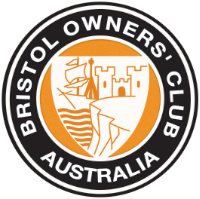The Bristol Aeroplane Company built aero engines and combat aircraft which helped win two world wars. After WWII, it looked to car manufacture to utilise its factory space and skilled workforce and, as war reparation, obtained rights to pre-war BMW car and engine designs.
These were developed, improved and re-engineered to become the first Bristol car, the model 400 of 1946. The BMW designed 2-litre, six cylinder engine was used in Bristol cars until 1961 and powered other makes to sporting success including Frazer Nash, AC, Cooper, Lotus and Lister. Chrysler V8s were introduced with the 407 in 1961 and were used on all models up to the Bristol Fighter of 2005, which was powered by an 8-litre, Chrysler V10 engine. In 2011, the Bristol Car Company ceased production and was taken over by Kamcorp Autocraft, a Division of the Frazer Nash Group. In 2016, the revived company launched a speedster named the Bullet, a bespoke design with a visible Bristol pedigree.
Bristol models
6 Cylinder
1940s — 400, 401, 402
1950s — 403, 404, Arnolt-Bristol, 405, 405dh, 406, 406 Zagato
Bristol 400
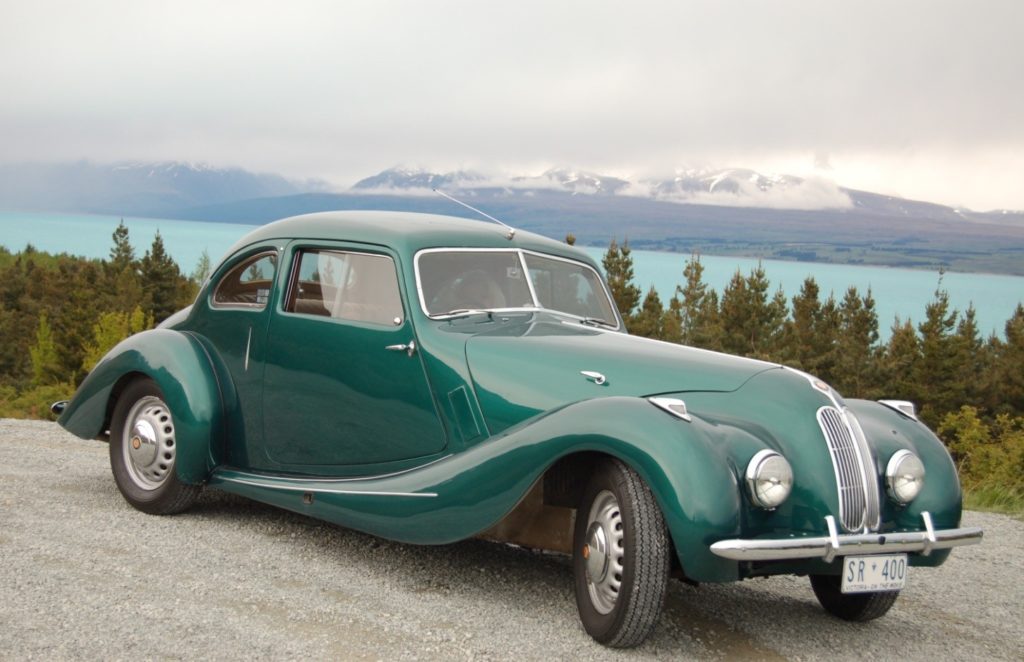
1947-1950 — 430 built — 63 in Australia
The prototype Bristol cars were built in 1946 and exhibited at the January 1947 Geneva Motor show. Some 421 Standard bodied Type 400s were built from 1947 to 1950 and 94 cars were exported new to Australia. There are currently 55 model 400s registered to members in the Bristol Owners’ Club of Australia.
Selling in the UK for £2,373, it was an exceptional vehicle built to aero-engineering standards and it appealed to the enthusiast by its appearance, handling and performance, having a 1971cc 6-cylinder engine producing 80bhp giving a top speed of 94mph. The deep box section chassis had a 9’ 6” wheelbase that was to become traditional for nearly all Bristols built thereafter.
The body used a basic structure of seasoned ash and spruce that was steel covered and the two doors were timber framed. The bonnets, door sheathing and boot lid were of light alloy. The upholstery was in the finest Connolly leather. A comprehensive display of instruments was set into a solid timber dashboard.
SPECIFICATIONS
Engine — Type 85A 80bhp @4200rpm Capacity: 1971cc Bore: 66mm Stroke: 96mm
Gearbox — Bristol 4-speed with a freewheel 1st gear
Size — Overall length: 15’3” (4660mm) Overall height: 4’11” (1499mm) Overall width: 5’4” (1830mm)
Brakes — Lockheed 11-inch hydraulic drums
Suspension — Front: independent transverse leaf springs Rear: longitudinal torsion bars and Bristol Lever Arm Dampers
Weight — 2580lbs (1170kg)
Tyres — 5.50” x 16”
Bristol 401
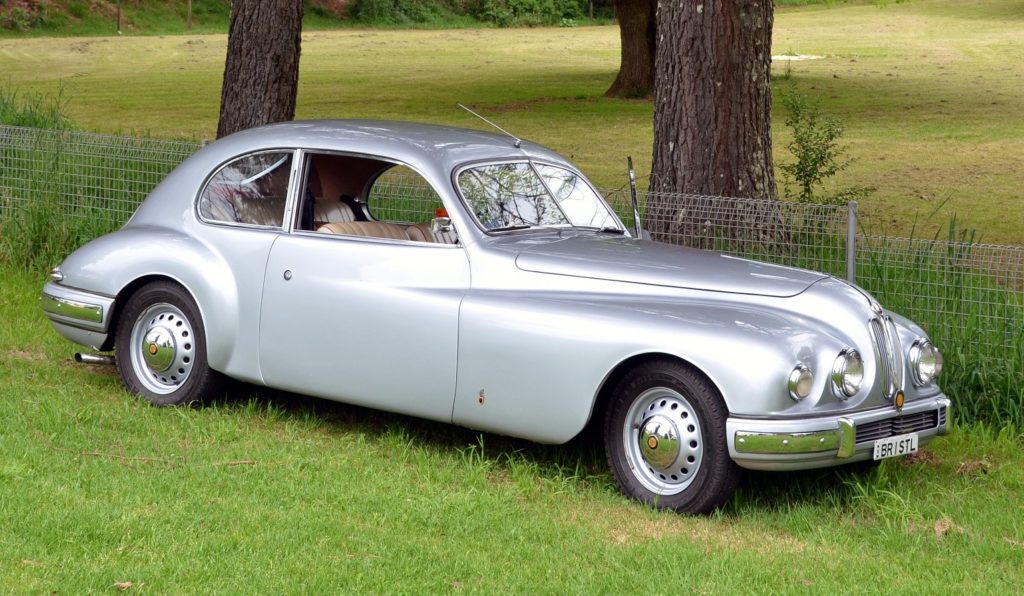
1949-1953 — 612 built — 46 in Australia
The successor to the 400 continued as a two-door four-seat sporting saloon, built on the same basic chassis as the 400. Triple Solex carburetors replaced the SUs of the 400, though power remained the same at 85 bhp. It has a larger and completely restyled “aerodyne” body built using the Superleggera principle of small diameter welded steel tubing around which aluminium panels are wrapped. The finished design is Bristol's own aerodynamic refinement of an original treatment by Italian coach builder, Touring of Milan. The 402 and 403 have similar construction.
The second model Bristol, the type 401, was launched in 1949 and was to become the most popular of all models. Some 605 Type 401s were built from 1949 to 1953 and 62 cars were exported to Australia. There are currently 35 model 401s registered to members in the Bristol Owners’ Club of Australia.
Selling in the UK for £3,213, it was a handsome vehicle with aerodynamic flowing lines, engineered to aircraft standards and it appealed to the enthusiast by its appearance, handling and performance, having a 1971cc 6‑cylinder engine producing 85bhp, giving a top speed of 98mph. The deep box section chassis had a 9’ 6” wheelbase that was traditional for nearly all Bristols built.
The all aluminium body panels were clinched to a lightweight steel support framework. The upholstery was in the finest Connolly leather. A comprehensive display of instruments was set into a solid timber dashboard.
SPECIFICATIONS
Engine — Type 85C 85bhp @4500rpm Capacity: 1971cc Bore: 66mm Stroke: 96mm
Gearbox — 4-speed with Freewheel 1st. Synchromesh either by Bristol or Borg Warner
Size — Overall length: 15’11” (4860mm) Overall height: 5’0” (1520mm) Overall width: 5’7” (1700mm)
Brakes — Lockheed 11-inch hydraulic drums
Suspension — Front: independent transverse leaf springs Rear: longitudinal torsion bars and Bristol Lever Arm or Telescopic dampers
Weight — 2700lbs (1255kg)
Tyres — 5.50” or 5.75”x 16”
Bristol 402
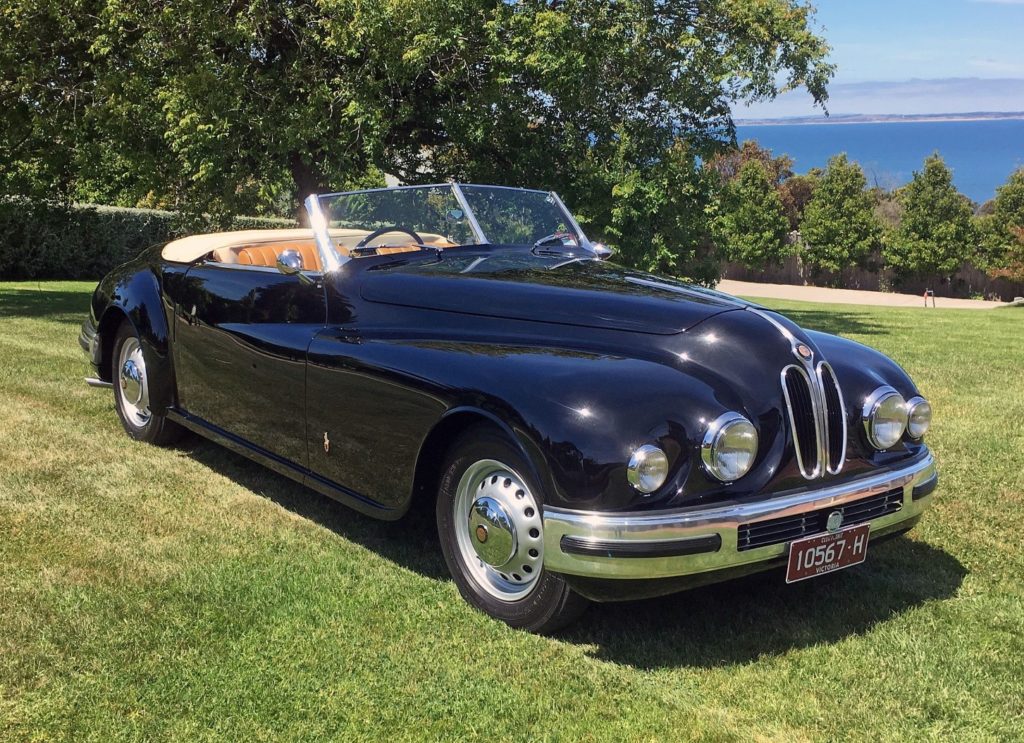
1949-1950, 21 built, 4 in Australia
A convertible version of the 401.
The first production convertible Bristol. Only 20 Type 402s (plus 1 prototype) were built from 1949 to 1950 and two cars were exported new to Australia. There are currently three type 402s registered to members in the Bristol Owners’ Club of Australia, with one other belonging to a non member.
Selling in the UK for £3,213, it has the same basic bodywork design as the 401 with aerodynamic flowing lines, engineered to aircraft standards and it appealed to the enthusiast by its appearance, handling and performance, having a 1971cc 6-cylinder engine producing 85bhp giving a top speed of 98mph. The deep box section chassis had a 9’ 6” wheelbase that was traditional for nearly all Bristols built.
The all-aluminium body panels were clinched to a lightweight steel tube support framework (Superleggera style). The upholstery was in the finest Connolly leather. A comprehensive display of instruments was set into a beige painted aluminium dashboard, but in the same design as the Type 401.
SPECIFICATIONS
Engine — Type 85C 85bhp @4500rpm Capacity: 1971cc Bore: 66mm Stroke: 96mm
Gearbox — Bristol 4-speed with Freewheel 1st gear
Size — Overall length: 15’10” (4820mm) Overall height: 5’0” (1520mm) Overall width: 5’5” (1640mm)
Brakes — Lockheed 11-inch hydraulic drums
Suspension — Front: independent transverse leaf spring Rear: longitudinal torsion bars and Bristol Lever Arm dampers all round.
Weight — 2632lbs (1194kg)
Tyres — 5.50” or 5.75”x 16”
Bristol 403
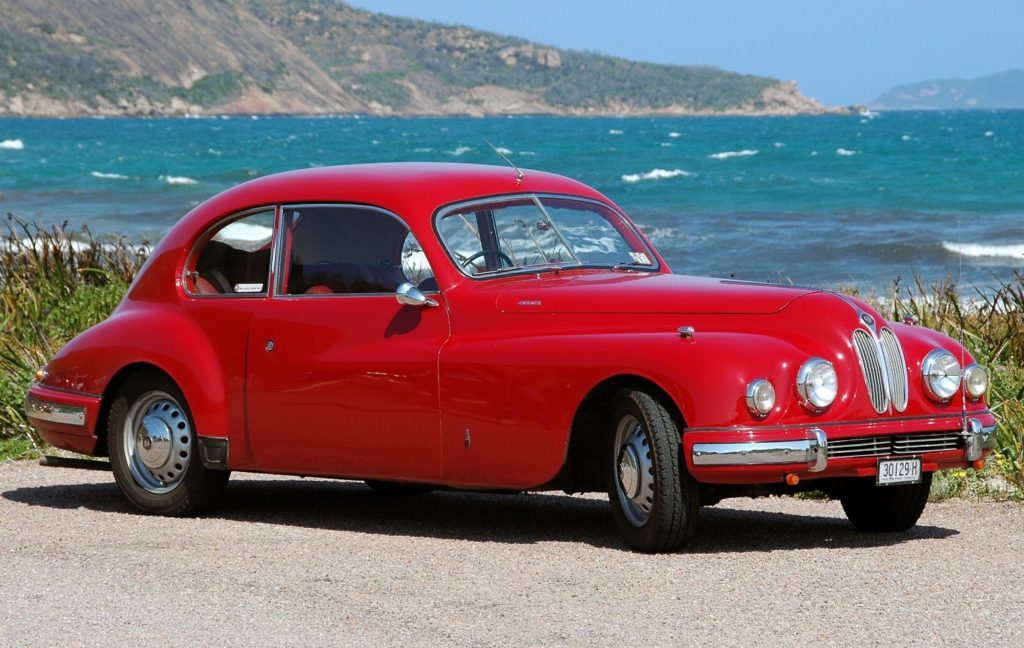
1953-1955, 281 built, 37 in Australia
An updated version of the 401 with more powerful engine and better brakes, gearbox, and improved suspension, among other refinements. Some 275 Type 403s were built from 1953 to 1955 and 40 cars were exported to Australia. There are currently 28 model 403s registered to members in the Bristol Owners’ Club of Australia.
Selling in the UK for £2,976, it had aerodynamic flowing lines, engineered to aircraft standards and it appealed to the enthusiast by its appearance, handling and performance, having a 100A 1971cc 6-cylinder engine producing 100bhp giving a top speed of 104mph. The deep box section chassis had a 9’6” wheelbase that was traditional for nearly all Bristols built.
The all aluminium body panels were clinched to a lightweight steel support framework. The upholstery was in the finest Connolly leather. A comprehensive display of instruments was set into a veneered timber dashboard.
SPECIFICATIONS
Engine — Type 100A 100bhp @ 5000 rpm Capacity: 1971cc Bore: 66mm Stroke: 96mm
Gearbox — Borg Warner CR5 4-speed with Freewheel in 1st gear
Size — Overall length: 15’11” (4860mm) Overall height: 5’0” (1520mm) Overall width: 5’7” (1700mm)
Brakes — Lockheed 11-inch hydraulic and Alfin drums
Suspension — Front: independent transverse leaf springs Rear: longitudinal torsion bars and Tubular Shock Absorbers
Weight — 2700lbs (1255kg)
Tyres — 5.75”x 16”
Bristol 404
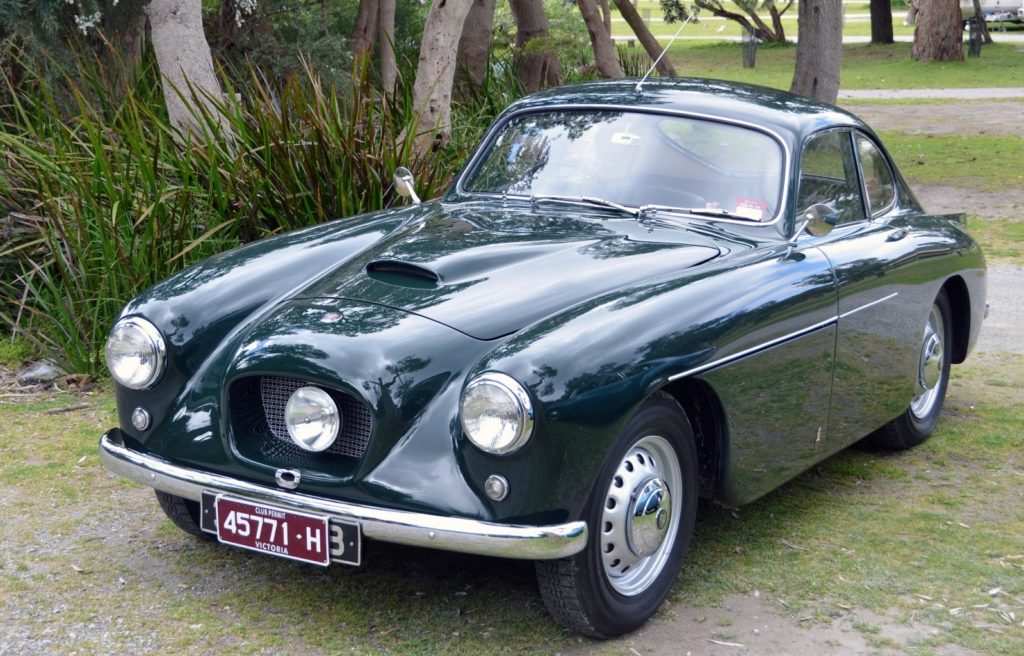
1953-1955, 52 built, 6 in Australia
A sports car, marketed as "the Businessman's Express", the 404 was built on a shortened version of the standard chassis of 8’01/4”. With the 125 bhp, "sports", engine it could exceed 120 mph, a performance benchmark for the era. The 404 was styled in-house by Bristol's chief designer, Dudley Hobbs, featuring a distinctive radiator air intake modelled on those of the Bristol Brabazon airliner. It was the first of many Bristols to house its battery and spare wheel behind hatches in the front wings to improve weight distribution while, inside, a distinctively modern instrument binnacle also made its first appearance.
Only 51 model 404s were built from 1953 to 1955 parallel with the 403 and four cars were exported to Australia. There are currently six model 404s registered to members in the Bristol Owners’ Club of Australia.
Selling in the UK for £3,542, its bodywork was of steel, light alloy and timber composite construction and engineered to aircraft standards and it appealed to the enthusiast by its appearance, handling and performance, having a choice of 1971cc 6-cylinder engine producing 85bhp or 125bhp giving a top speed of well over 100mph. The 404 has no boot lid and access to the boot is from inside the cabin. It was the first Bristol to have the spare wheel and electrics located under the front wing flaps.
SPECIFICATIONS
Engine — Type 100B or C, 105/125bhp @ 5000 rpm Capacity: 1971cc Bore: 66mm Stroke: 96mm
Gearbox — Borg Warner CR7 4-speed with Freewheel in 1st gear
Size — Overall length: 14’3” (4350mm) Overall height: 4’8” (1410mm) Overall width: 5’8” (1720mm)
Brakes — Lockheed 12-inch hydraulic and Alfin drums on front with 11-inch rear
Suspension — Front: independent transverse leaf springs Rear: longitudinal torsion bars and Tubular Shock Absorbers
Weight — 2300lbs (1043kg)
Tyres — 5.50”x 16”
Arnolt Bristol
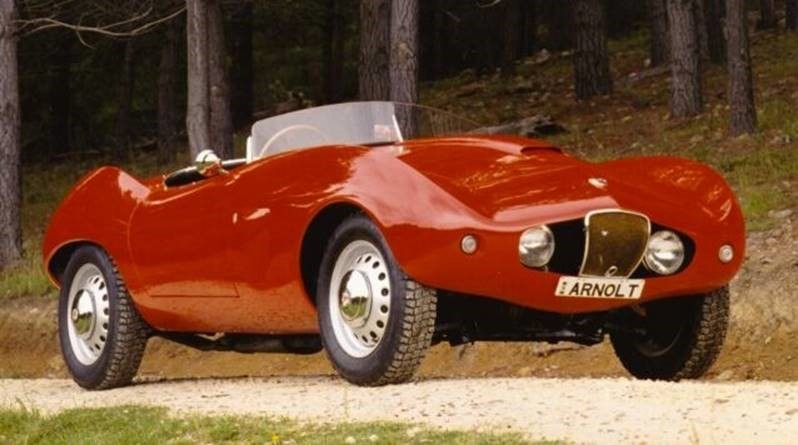
An American, SH “Wacky” Arnolt, purchased short wheelbase Type 404 chassis and Bristol Sports engines and sent them to Bertone body works in Turin Italy where they were fitted with two-door sports–racing bodies. Some 142 Arnolt Bristols were built from 1953 to 1954. About 120 are known to exist. Three Arnolt Bristol cars are registered to members in the Bristol Owners’ Club of Australia.
Selling in the US for $4,250, its bodywork and body frame was of steel construction with aluminium bonnet and boot panels and engineered to aircraft standard. It appealed to the American sports car enthusiast by its appearance, handling and performance, with the 1997cc 6-cylinder engine producing 130bhp giving a top speed of up to 110 mph.
The Arnolt Bristol was successfully raced throughout the US and at the Sebring circuit in Florida. Arnolts won their class in 1955, attaining speeds of 113mph over the 12 hours.
SPECIFICATIONS
Engine — Type BS1 Mk2 130bhp @ 5500rpm Capacity: 1971cc Bore: 66mm Stroke: 96mm
Gearbox — Bristol CR6 4-speed Sports gearbox with a high ratio fixed 1st gear
Size — Overall length: 13’11 (4200mm) Overall height: 3’8” (1090mm) Overall width: 5’8” (1720mm)
Brakes — Lockheed 11inch hydraulic drums
Suspension — Front: independent transverse leaf springs Rear: longitudinal torsion bar and telescopic dampers
Weight — 2300lbs (1043kg)
Tyres — 5.50”x 16”
Bristol 405

1954-1958, 258 built, 17 in Australia
While the 405 was identical to the 404 from the windscreen forwards, it was in fact the only four-door saloon Bristol ever produced. With standard overdrive and an engine producing 105 bhp, the 405 maintained Bristol's reputation for producing cars capable of carrying four people over long-distances, at high speeds, in comfort and safety.
Built on a standard 9’6” chassis, the Type 405 saloon was the first and only 4-door Bristol. Some 297 Type 405s were built from 1954 to 1958 and 16 cars were exported new to Australia. There are currently 20 model 405s registered to members in the Bristol Owners’ Club of Australia.
Selling in the UK for £3,188, its bodywork was of light alloy with timber and steel framework and engineered to aircraft standards. It appealed to the enthusiast by its appearance, handling and performance having a of 1971cc 6-cylinder engine producing 105bhp giving a top speed of well over 100mph.
The Type 405 was criticised for having the rear doors too small, restricting access. It shared the innovation with the 404 of having the spare wheel and electrics located under the front wing flaps which gave a near 50/50 weight distribution front and rear.
SPECIFICATIONS
Engine — Type 100B2 105bhp @5000rpm Capacity: 1971cc Bore: 66mm Stroke: 96mm
Gearbox — Bristol BWCR11 4-speed with Freewheel 1st gear and Overdrive available in 4th
Size — Overall length: 15’9” (4800mm) Overall height: 4’9” (1460mm) Overall width: 5’8” (1720mm)
Brakes — Lockheed 12-inch hydraulic with Alfin drums
Suspension — Front: independent transverse leaf springs Rear: longitudinal torsion bars and telescopic dampers
Weight — 12712lbs (1230kg)
Tyres — 5.75” x 16”
Bristol 405 Drophead
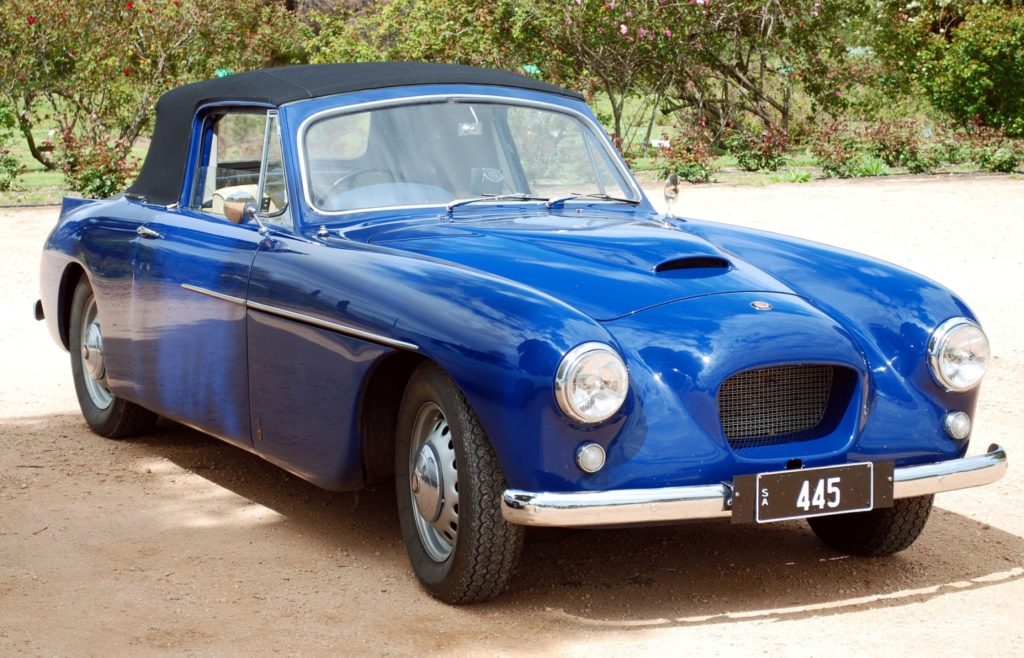
Built on a standard 9’6” chassis, the Type 405 Drophead bodywork was made by Abbotts of Farnham. Some 43 model 405 convertibles were built from 1954 to 1958 and no new cars were exported to Australia. No Type 405 Dropheads are currently resident in Australia.
Selling in the UK for £3,188, the same as the saloon, its bodywork was of light alloy with timber and steel body frame and engineered to aircraft standards. It appealed to the enthusiast by its appearance, handling and performance, having a 1971cc 6-cylinder engine producing 105bhp giving a top speed of well over 100mph. The 405 Drophead has two wide doors and a steel boot lid. It shared the innovation with the 404 of having the spare wheel and electrics located under the front wing flaps.
SPECIFICATIONS
Engine — Type 100B 105bhp @5000rpm Capacity: 1971cc Bore: 66mm Stroke: 96mm
Gearbox — Bristol BWCR11 4-speed with Freewheel 1st gear and Overdrive available in 4th
Size — Overall length: 15’9” (4800mm) Overall height: 4’9” (1460mm) Overall width: 5’8” (1720mm)
Brakes — Lockheed 12-inch hydraulic with Alfin drums
Suspension — FFront: independent transverse leaf springs Rear: longitudinal torsion bars and telescopic dampers
Weight — 12712lbs (1230kg)
Tyres — 5.75” x 16”
Bristol 406
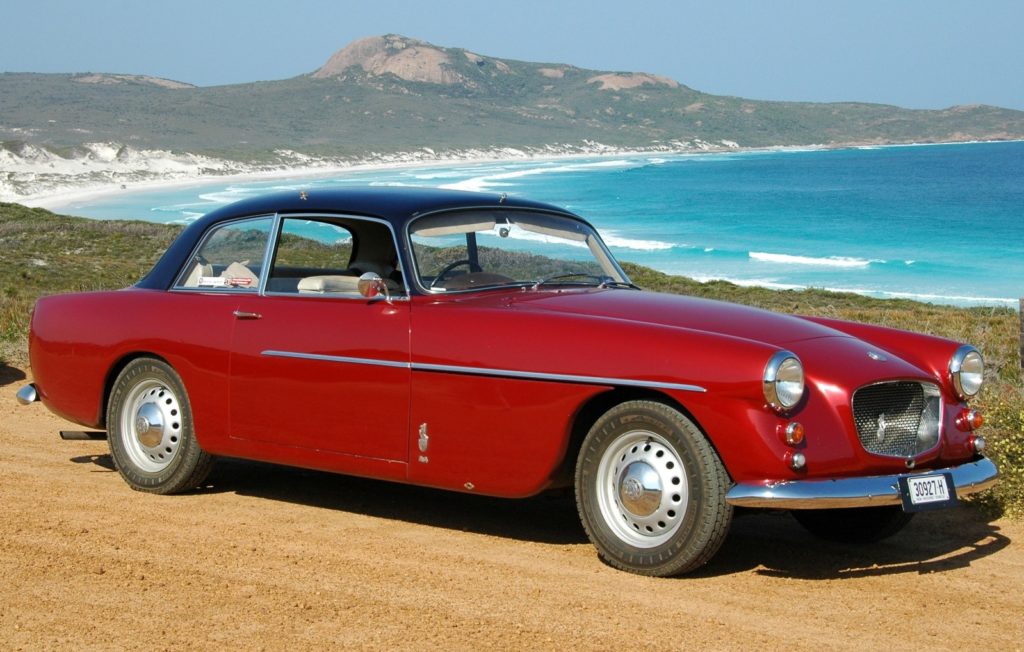
1957-1961, 181 built, 6 in Australia
A heavier and more luxurious two-door, four-seat saloon, the 406 introduced a body style that formed the template for Bristols until the 1970s. Powered by the final 2.2-litre version of the BMW-derived 6-cylinder engine, the car's performance was less overtly sporting than its predecessors. The 406 was the first production car to use a Watt linkage to locate the rear axle and featured four-wheel disc brakes. Six chassis were fitted with Zagato designed and built bodies.
Built on a standard 9’6” chassis, the Type 406 saloon has an upgraded Type 110 2.2-litre engine. Some 178 model 406s were built from 1958 to 1961 and only two cars were exported new to Australia. Four Type 406s and one Zagato bodied 406 are registered to members in the Bristol Owners’ Club of Australia.
Selling in the UK for £4,493, its bodywork was of aluminium panels over steel construction and engineered to aircraft standard. It appealed to the enthusiast by its appearance, handling and performance, with the 2216cc 6-cylinder engine producing 105bhp giving a top speed of well over 100mph. This was the last 6 cylinder Bristol.
The 406 had servo assisted disc brakes and increased interior room and comfort. The spare wheel and electrics are located under the front wing flaps.
SPECIFICATIONS
Engine — Type 110 105bhp @4700rpm Capacity: 2216 cc Bore: 68.69mm Stroke: 99.64mm
Gearbox — Bristol BWCR11 4-speed with Freewheel 1st gear and Overdrive available in 4th
Size — Overall length: 16’4” (5349mm) Overall height: 5’0” (1524mm) Overall width: 5’8” (1720mm)
Brakes — Dunlop disc servo assist
Suspension — FFront: independent transverse leaf springs Rear: longitudinal torsion bars and telescopic dampers
Weight — 3010lbs (1368kg)
Tyres — 6.00” x 16”
Bristol 406Z (Zagato)
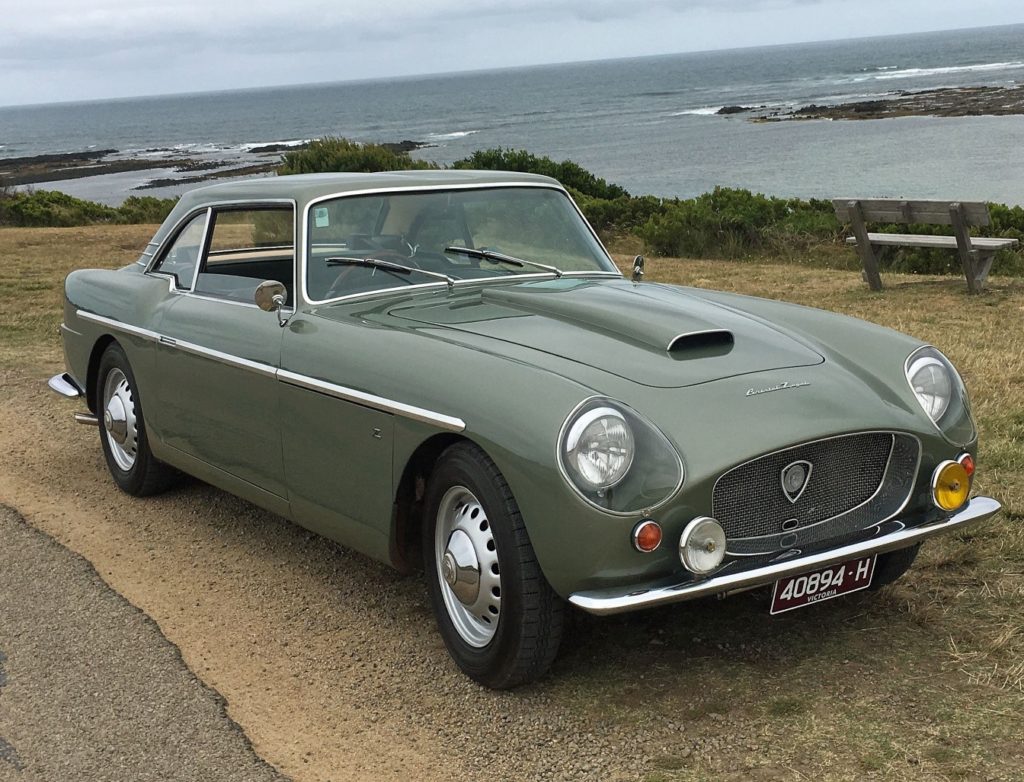
Six Type 406 chassis/engine units were sent to Italy and fitted with special lightweight bodies by the famous coach builders Carrozzeria la Zagato of Milan for Anthony Crook Motors.
The standard 9’ 6” chassis and Type 110 2.2-litre engine was used to produce these six saloons. A Prototype shortened chassis of 8’6” was used to produce one coupe by Zagato, with 110S engine giving 130hp.
A saloon was first exhibited on the Zagato stand at the London Motor Show in 1960. One Type 406 Zagato is registered to a member of the Bristol Owners’ Club of Australia.
The cars were produced for Anthony Crook, not Bristol Cars Ltd. Anthony Crook also rebodied four used type 400 or 401 cars, one of which is owned by a BOCA Member.
SPECIFICATIONS
Engine — Type 110 105bhp @4700rpm Capacity: 2216 cc Bore: 68.69mm Stroke: 99.64mm
Gearbox — Bristol BWCR11 4-speed with Freewheel 1st gear and Overdrive available in 4th
Size — Overall length: 16’4” (4978mm) Overall height: 5’0” (1524mm) Overall width: 5’8” (1720mm)
Brakes — Dunlop disc servo assist
Suspension — FFront: independent transverse leaf springs Rear: longitudinal torsion bars and telescopic dampers
Weight — Approximately 2800lbs (1270kg)
Tyres — 6.00” x 16”
Bristol 407
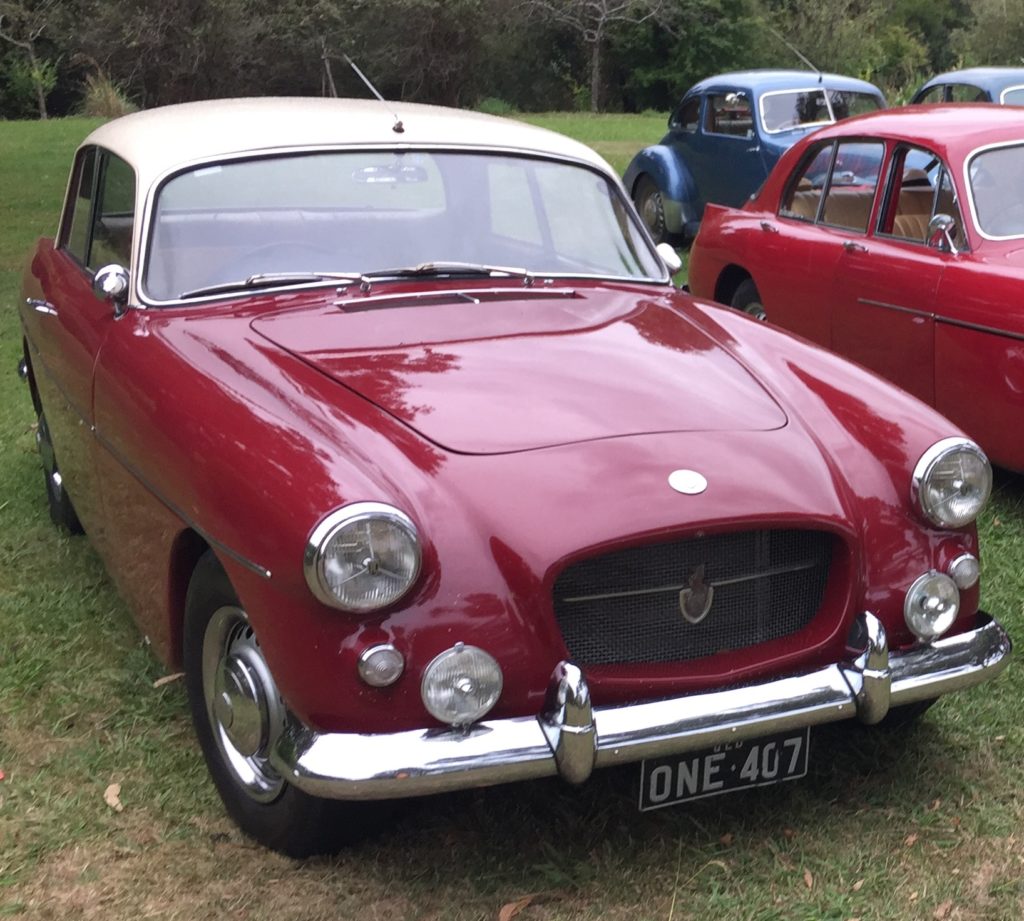
1961-1963, 88 built, 2 in Australia
Visually, the 407 is near-identical to the preceding model 406, although slightly larger in many dimensions. The size increase was required to accommodate a Canadian built 5.1-litre Chrysler V8 engine and push button Torqueflite automatic transmission which replaced the Bristol 6-cylinder unit. Bristol's program to develop a new 3-litre engine had been cancelled and the American engine was a convenient solution to provide the power and performance expected of an exclusive, luxury car. All subsequent Bristol cars, up until receivership in 2011, were to be powered by Chrysler engines.
This is the first V8 powered Bristol, designed to compete with upmarket marques of that era. Launched in 1961, 88 were built, costing £5,141. There is one 407 registered to members in the Bristol Owners’ Club of Australia. Powered by a specially built Chrysler Hemi V8 in Canada and tuned for the car by Bristol.
Built on a steel box type ladder frame chassis, with aluminium body panels. It has a Torqueflite Chrysler pushbutton automatic 3-speed gearbox and is capable of speeds up to 125mph. 250 HP and very fast. It also marked the end of the era of the beautiful 2-litre six engine that powered all the previous Bristols models from 1946.
SPECIFICATIONS
Engine — V8 @ 90 degrees by Chrysler. 5,130 CC, overhead valves, compression ratio of 9-1. Carburetor: Carter 4 barrel down draught, auto choke. Carter mechanical fuel pump. 250 bhp at 4400rpm
Gearbox — Chrysler Torqueflite pushbutton 3-speed automatic
Size — Overall length: 16’7”(5055mm) Overall height: 4’11” (149mm) Overall width: 5’8” (1830mm)
Brakes — Dunlop disc with Lockheed vacuum servo. Disc diameter 11½ inches front and rear
Steering — Marles worm type, 4 turns lock to lock
Suspension — Front: Independent transverse wishbones, coil springs and antiroll torsion bars. Rear: Rigid axle, longitudinal torsion bars, trailing link, transverse watt linkage. Shock absorbers, Armstrong telescopic
Weight — 3584lbs (1625.7kg)
Tyres — 6.00” x 16”
Bristol 408
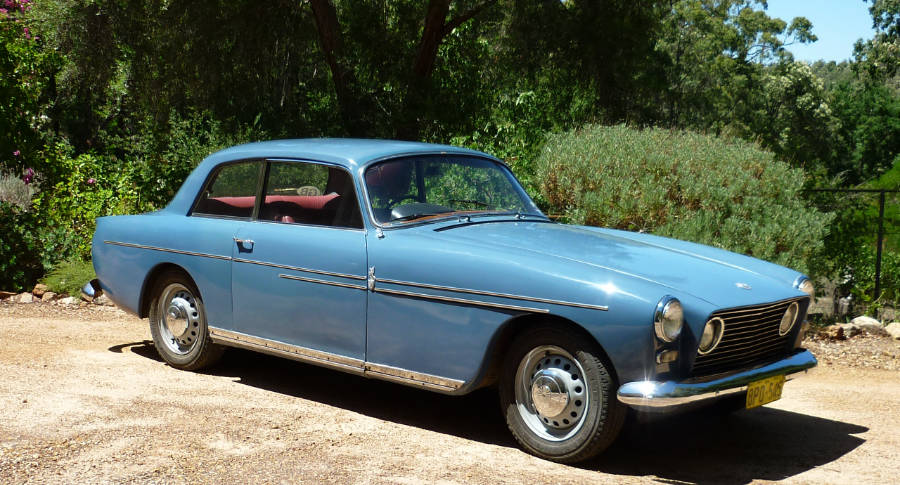
1963-1965, 83 built, 4 in Australia
Mechanically very similar to the 407, the engine capacity increased slightly to 5.2 litres. The 408 introduced Armstrong Select-a-ride damping and was, otherwise, a visual update of the 407 with a wider rectangular grille opening and headlights mounted on flat panels.
This is the second model of the Chrysler V8s. Launched in 1964, some 83 were built at a cost of £4,459. There are four model 408s registered to members in the Bristol Owners’ Club of Australia. Only one was sold new in Australia.
There are some subtle differences in the way of styling with this new model. The traditional air scoop in the bonnet, which was the hallmark for many previous Bristols, made way for a wide, shallow air intake, with a stainless steel grill. The changes were complete with two 5½-inch headlamps built into the grill. The flatter bonnet and flatter roof made the car look longer and lower, yet it is actually a bit shorter. Extra side moldings and kick strips on the door sills completed the subtle changes.
SPECIFICATIONS
Engine — V8 @ 90 degrees by Chrysler. 5,130 CC, overhead valves, compression ratio of 9-1. Carburetor: Carter 4 barrel down draught, auto choke. Carter mechanical fuel pump. 250 bhp at 4400rpm
Gearbox — Chrysler Torqueflite pushbutton 3-speed automatic
Size — Overall length: 16’ (4902mm) Overall height: 4’11” (149mm) Overall width: 5’ 8” (1727mm)
Brakes — Dunlop disc with Lockheed vacuum servo. Disc diameter 11½ inches front and rear
Steering — Marles worm type, 4 turns lock to lock
Suspension — Front: Independent transverse wishbones, coil springs and antiroll torsion bars. Rear: Rigid axle, longitudinal torsion bars, trailing link, transverse watt linkage. Shock absorbers, Armstrong telescopic
Weight — 3584lbs (1625.7kg)
Tyres — 6.00” x 16”
Bristol 409
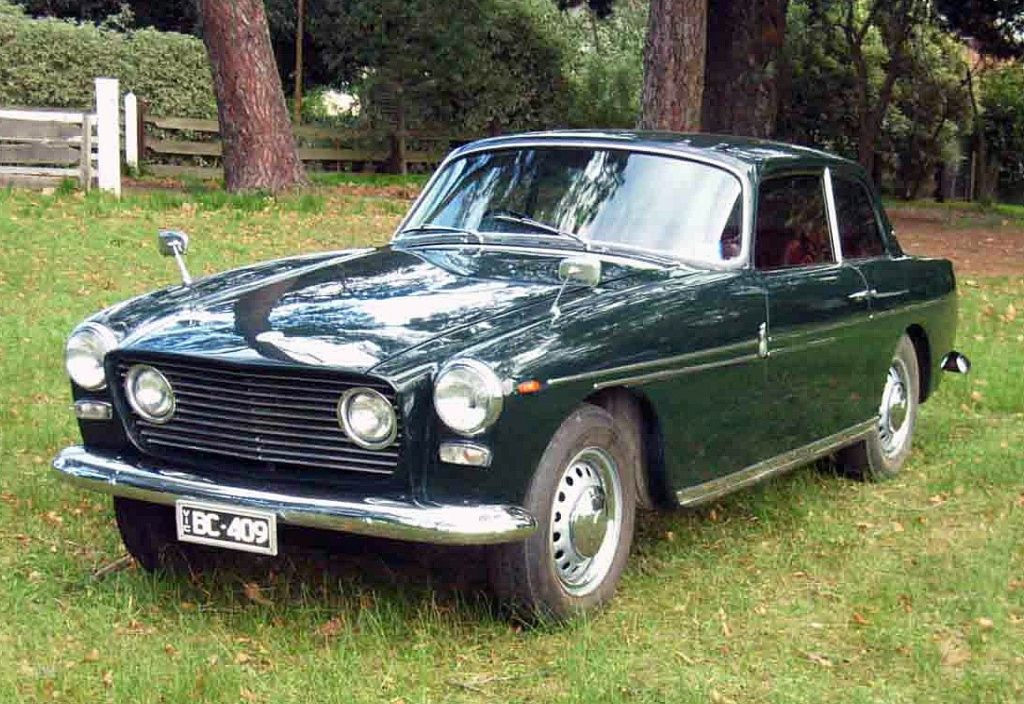
1965-1967, 74 built, 4 in Australia
Subtle change to the grille opening, softer springs, higher ratio differential, more power from the engine and, a lighter, alloy, Torqueflite gearbox.
Launched in 1965 with slight changes, there were 79 cars built at a cost of £5,150. There are six model 409s registered to members of the Bristol Owners’ Club of Australia.
A small increase in engine size, with mechanical tappets, special camshaft and higher differential gearing, to give better fuel economy and 10mph higher top speed in excess of 125 mph. The gearbox holds second gear for faster acceleration. A gearbox parking brake, as well as separate calipers for the handbrake. Electric demisting also a new addition. New Burgess silencers have been designed, with an asbestos sandwich and central stainless steel tube, for more effective noise damping and longer life. Girling disc brakes all around are very effective and do not fade after many high speed applications. A few subtle changes to the body being the radiator raised at the top and bottom, giving better airflow.
SPECIFICATIONS
Engine — V8 @ 90 degrees by Chrysler. 5,211 CC, overhead valves, compression ratio of 9-1. Carburetor Carter 4-barrel down draught, auto choke. Carter mechanical fuel pump. 250 bhp at 4400rpm
Gearbox — Chrysler Torqueflite pushbutton 3-speed automatic, hold on 2nd Gear
Size — Overall length: 16’ (4902mm) Overall height: 4’11” (149mm) Overall width: 5’ 8” (1727mm)
Brakes — Girling discs with Lockheed vacuum servo. Disc diameter 11½ inches front and rear
Steering — Marles worm type, 4 turns lock to lock. Turning Circle 39ft
Suspension — Front: Independent transverse wishbones, coil springs and antiroll torsion bars. Rear: Rigid axle, longitudinal torsion bars, trailing link, transverse watt linkage. Shock absorbers, Armstrong Selectaride shock absorbers on the rear
Weight — 3520lbs (1600kg)
Tyres — 6.00” x 16”
Bristol 410
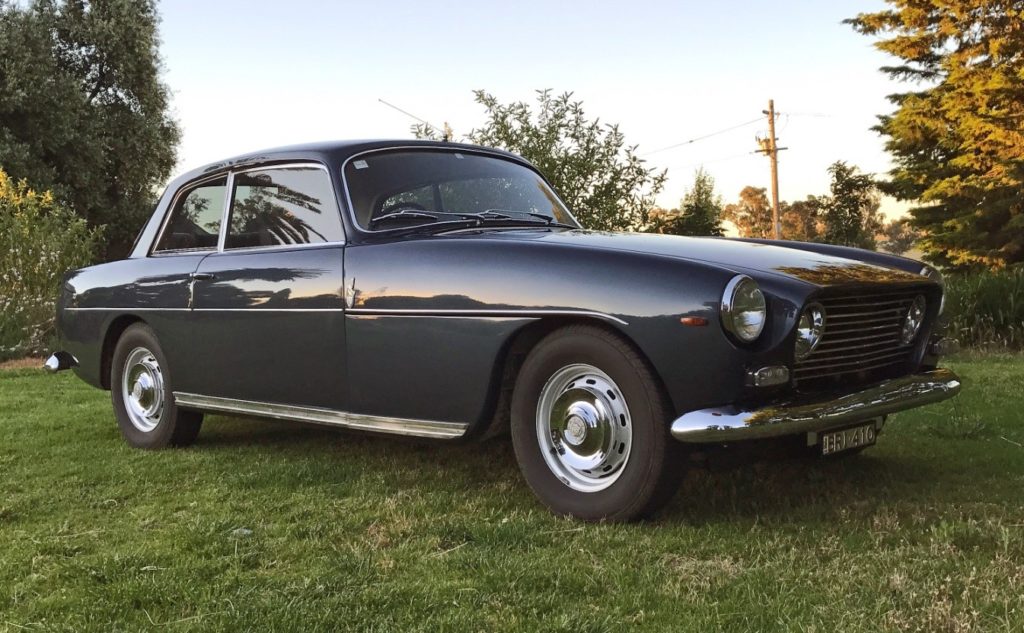
1968-1969, 82 built, 3 in Australia
The 410 sported a comprehensive new styling treatment, though still appears very similar to the 409. Dual hydraulic circuits improved braking, while fifteen inch wheels (down from 16 inch) and wider rims acknowledged changing tyre standards. Centre mounted gear shift replaces push buttons. This is the last Bristol to use the distinctive two-spoke Bluemels steering wheel which had been introduced with the 401 in 1948.
Launched in 1967, there were 102 cars produced at a cost of £5,163. There are four model 410s registered to members of the Bristol Owners’ Club of Australia.
Further improvements and modernisation came with this new model: Walnut Burr, Connolly hide and Wilton carpets, complemented by the wonderful aircraft-inspired dash and the lovely sound of doors closing with aircraftsman precision. Power steering is now standard, as is the demisting rear window. The engine remains the same with up to 120mph plus for the four spoilt occupants. Luggage space is generous, made possible by the clever design of the front wings, which open up to reveal the spare on the LHS and the battery, electrics and power boosters on the RHS. The running gear and performance stays much the same as the previous 409 model being quite ample, covering a standing quarter mile in 16.2 seconds and a top speed of 130mph.
SPECIFICATIONS
Engine — V8 @ 90 degrees by Chrysler. 5,211 CC, overhead valves, compression ratio of 9-1. Carburetor Carter 4-barrel down draught, auto choke. Carter mechanical fuel pump. 250 bhp at 4400rpm
Gearbox — Chrysler Torqueflite pushbutton 3-speed automatic, hold on 2nd Gear
Size — Overall length: 16’ 2” (4915mm) Overall height: 4’ 11” (1498mm) Overall width: 5’ 8” (1727mm)
Brakes — Girling discs with Lockheed vacuum servo. Disc diameter 11½ inches front and rear
Steering — ZF recirculating ball power assisted. 3.2 turns lock to lock Turning Circle 39ft
Suspension — Front: Independent transverse wishbones, coil springs and antiroll torsion bars. Rear: Rigid axle, longitudinal torsion bars, trailing link, transverse watt linkage. Shock absorbers, Armstrong Selectaride shock absorbers on the rear
Weight — 3528lbs (1600kg)
Tyres — 185” x 15”
Fuel tank — 18 gallons
Bristol 411
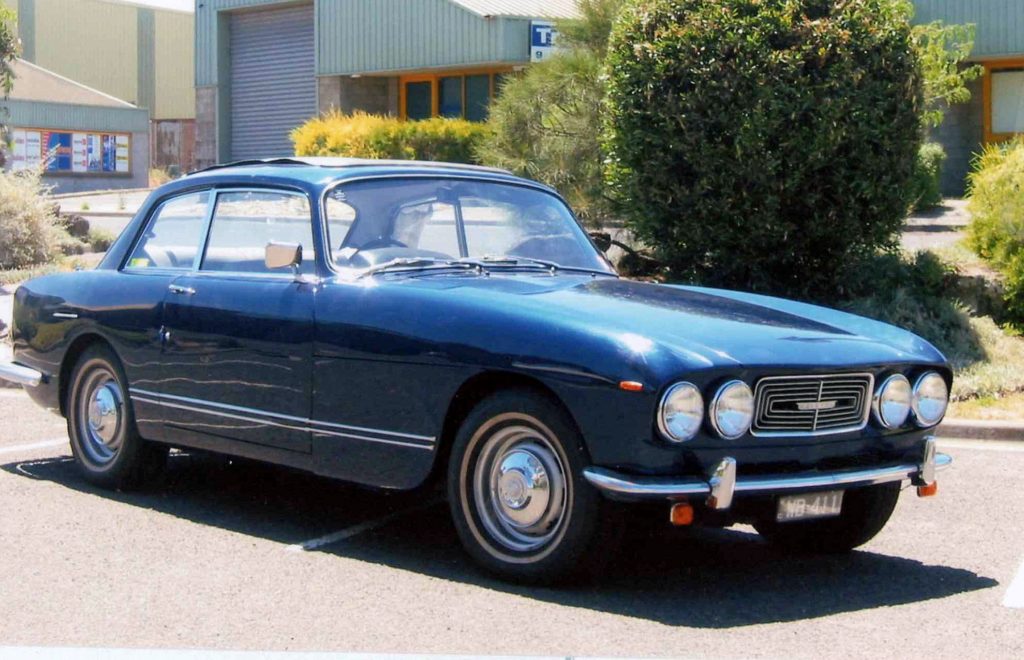
1969-1976, 287 built, 5 in Australia
A development of the 410, made in five series with engines ranging from 6.2 to 6.6 litres and top speed of 138 mph. A new styling treatment lowered the roofline, removed all trace of the 410's vestigial fins, and later series sported a new quad headlight front grille.
Built from 1970 to 1975 alongside the Supersonic Concorde jetliner, 287 cars were produced at the rate of four cars per week. The 1970 purchase cost was £6,997. There are seven model 411s registered to members of the Bristol Owners’ Club of Australia. The US market was killed off by their strict emission requirements and the 411 was very expensive (15 per cent less than a Rolls Royce) but it had a small but dedicated following. The Chrysler engine, which grew to 383 from 313 cubic inches now giving 335 HP and a top speed of 138mph at 5,500 rpm. Styling changes were wraparound bumpers and less chrome trim. All aluminium bodywork as in all Bristol cars. The 411 could be ordered in the color, trim and leather upholstery of your choice. Five series of the 411 were produced, concluding with the 411 Series 5 selling for £12,587 pounds.
SPECIFICATIONS
Engine — V8 @ 90 degrees by Chrysler. 6276CC (Series 3, 4 and 5 had 6566CC), overhead valves, compression ratio of 9-1. Carburetor Carter 4-barrel down draught, auto choke. Carter mechanical fuel pump. 335 bhp at 5200rpm
Gearbox — Chrysler Torqueflite Lever operated 3-speed automatic, hold on 2nd Gear
Size — Overall Length 16’ 1” (4900) Overall Height: 4’9” (1460) Overall width: 5’8” (1727)
Brakes — Girling discs with Lockheed vacuum servo. Disc diameter 11½ inches front and rear
Steering — ZF recirculating ball power assisted. 3.2 turns lock to lock Turning Circle 39ft
Suspension — Front: Independent transverse wishbones, coil springs and antiroll torsion bars. Rear: Rigid axle, longitudinal torsion bars, trailing link, transverse watt linkage. elescopic Koni shocks
Weight — 3724lbs (1690kg)
Tyres — 185” x 15”
Fuel tank — 18 gallons
Bristol 412 Beaufighter/Beaufort
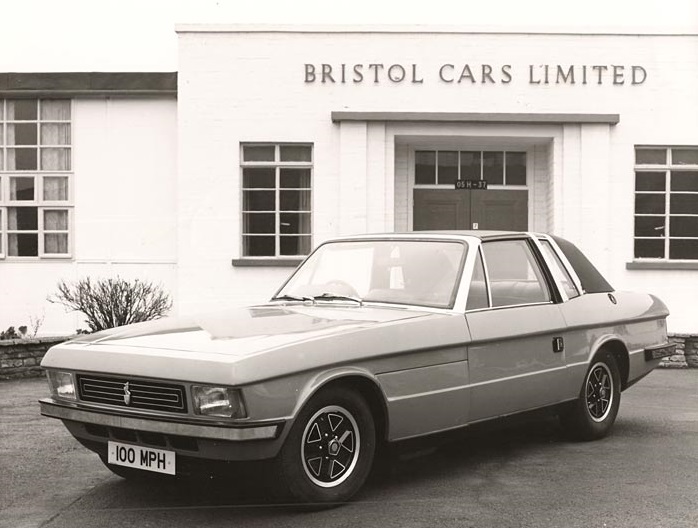
1975-1981, 287 built, 2 in Australia
A semi-convertible with targa-top, designed by Zagato, the 412's distinctive looks break from the gentle design evolution which had started with the 406. Launched with the 6.6 litre engine, the second series reduced capacity to 5.9 litres.
Built from 1975 to 1978, 98 cars were produced at a purchase cost of £14,584 pounds. There are four model 412s registered to members of the Bristol Owners’ Club of Australia. A new cleanly Zagato styled full four-seater convertible, the 412 has a massive chassis and a built-in rollover bar. Self-leveling suspension and Avon safety wheels were incorporated. The hard top is detachable and the rear section folds away one handed. Unique inertia seatbelts are fitted on rails, which slide away to allow easy access to the rear. There is an electronic speed hold, to allow for relaxed cruising. The heating and ventilation system was designed by the same engineers that designed the ventilation system for the Concorde. Engine size has been left the same, with ample power at hand. This Bristol is now comparable to the Aston Martin Lagonda, Ferrari 400A, V12 Jaguar and Mercedes 6.9. Each of these is a four-seater of impeccable flexibility and luxurious appointment, all capable of 140mph plus. A Turbo charger was added to the later 412/S3 Beaufighter which cost 38,000 pounds and could easily exceed 140 mph.
SPECIFICATIONS
Engine — V8 @ 90 degrees by Chrysler. 6556 CC, overhead valves, compression ratio of 8.2-1. Carburetor Carter 4-barrel down draught, auto choke. Carter mechanical fuel pump. bhp not specified
Gearbox — Chrysler Torqueflite Lever operated 3-speed automatic, hold on 2nd Gear
Size — Overall Length: 16’2” (4902) Overall Height: 4’8” (1440) Overall width: 5’9” (1770)
Brakes — Girling discs with Lockheed vacuum servo. Disc diameter 11½ inches front and rear
Steering — ZF recirculating ball power assisted. 3.2 turns lock to lock Turning Circle 39ft
Suspension — Front: Independent transverse wishbones, coil springs and antiroll torsion bars. Rear: Rigid axle, longitudinal torsion bars, trailing link, transverse watt linkage. Adjustable dampers
Weight — 3584lbs (1625kg)
Tyres — 205” x 15”
Fuel tank — 18 gallons
Bristol 603
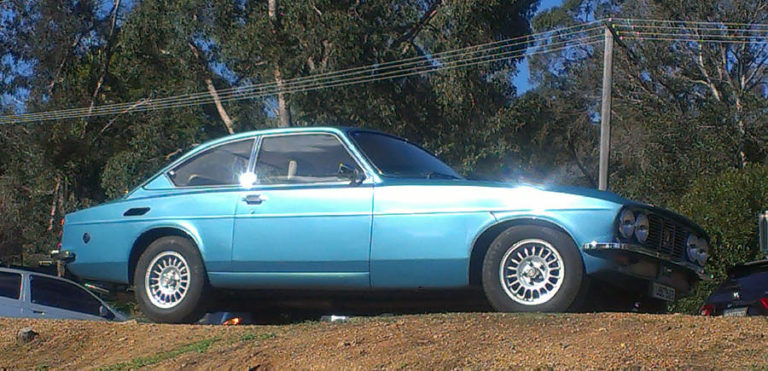
1976-1982, 80 built, 2 in Australia
Built from 1975 to 1982, there were 65 cars produced costing £29,284. There are two model 603s registered to members of the Bristol Owners’ Club of Australia. The 603 model is now in the company of the likes of Aston Martin V8 - £20,999, Jaguar XJ5.3 - £12,436, Maserati Kyalami - £21,996, Rolls Royce Corniche - £39,879 and Mercedes Benz 450 6.9 - £24,950. 17 coats of assorted paints, hand rubbed in between coats and perfect leather are typical of the fastidiousness of the artisan tradesmen, all with aircraft backgrounds. Boot and fuel filler cap are operated from the console, electric windows, two cigar lighters and interior lights that stay on for a few seconds after the doors are closed. The spare wheel is tucked away under the RHS mudguard, with the electrics and brake boosters in the LHS, as in all Bristols since the 406. Engine specifications remain basically the same as the 412 and weight is up as a result of more luxury.
SPECIFICATIONS
Engine — V8 @ 90 degrees by Chrysler. 5898 CC, (5211CC for Series E) overhead valves, compression ratio of 8-1. Carburetor Carter 4-barrel down draught, auto choke. Carter mechanical fuel pump. bhp not specified
Gearbox — Chrysler Torqueflite Lever operated 3-speed automatic, hold on 2nd Gear
Size — Overall Length 16’1” (4902) Overall Height: 4’9” (1430) Overall width: 5’9” (1760)
Brakes — Girling discs with Lockheed vacuum servo. Disc diameter 11½ inches front and rear
Steering — ZF recirculating ball power assisted. 3.2 turns lock to lock Turning Circle 39ft
Suspension — Front: Independent transverse wishbones, coil springs and antiroll torsion bars. Rear: Rigid axle, longitudinal torsion bars, trailing link, transverse watt linkage. Adjustable dampers
Weight — 3931lbs (1783kg)
Tyres — 205” x 15”
Fuel tank — 18 gallons
Bristol Brigand and Britannia
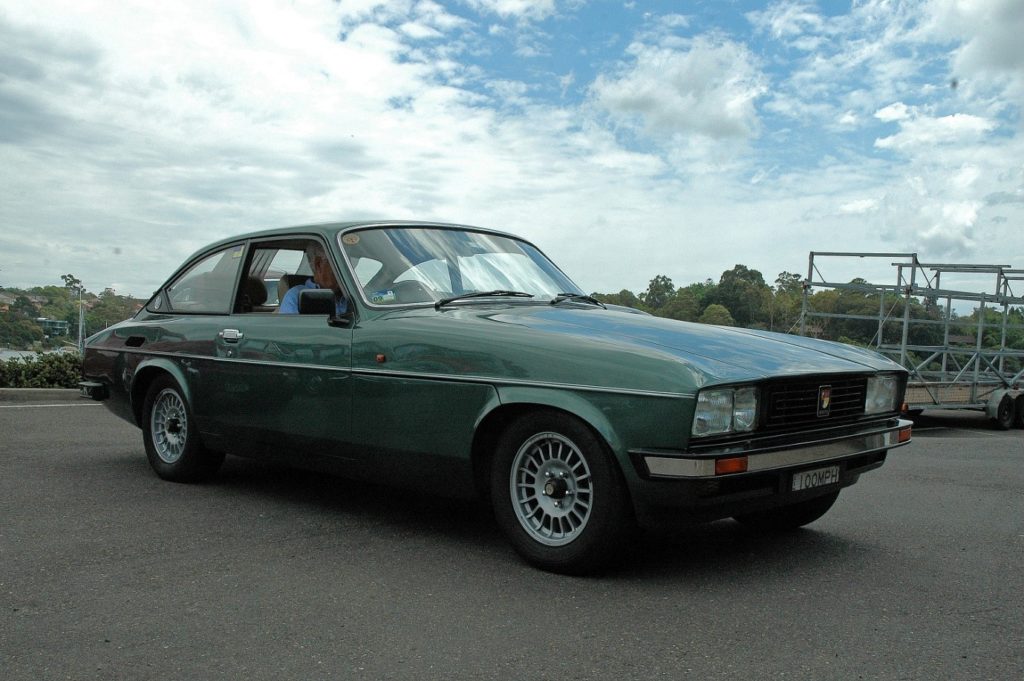
(Photograph above of a Britannia)
Built between 1982 and 1993, 31 cars were produced at a purchase price of £46,843. There are two model Britannias registered to members of the Bristol Owners’ Club of Australia.
These two new models differed only by the Brigand receiving a turbo, to take it to be an immensely fast luxury car, in fact the fastest four-seater in the world. A new body, rectangular headlamps and protruding tail lights, added a touch of modernity. The arrival of the new models saw the end to Bristol’s numbering system, and subsequent models would be named after the company’s aircraft days. The new styling gave the boot much luggage space, enough for eight regular suitcases and bountiful space for four large passengers. The Britannia will accelerate 0-60 in 8 seconds, while the Brigand, with its turbo power, 0-60 in 6.7 seconds.
SPECIFICATIONS
Engine — V8 @ 90 degrees by Chrysler. 5900 CC, overhead valves, compression ratio of 8-1. Carburetor Carter 4-barrel down draught, auto choke. Carter mechanical fuel pump. bhp not specified
Gearbox — Chrysler Torqueflite Lever operated 3-speed automatic, hold on 2nd Gear
Size — Overall Length 16’1” (4902) Overall Height: 4’9” (1430) Overall width: 5’9” (1760)
Brakes — Girling discs with Lockheed vacuum servo. Disc diameter 11½ inches front and rear
Steering — ZF recirculating ball power assisted. 3.2 turns lock to lock Turning Circle 36ft
Suspension — Front: Independent transverse wishbones, coil springs and antiroll torsion bars. Rear: Rigid axle, longitudinal torsion bars, trailing link, transverse watt linkage. Adjustable dampers
Weight — 3850lbs (1746kg)
Tyres — 215” x 15”
Fuel tank — 18 gallons
Bristol Blenheim
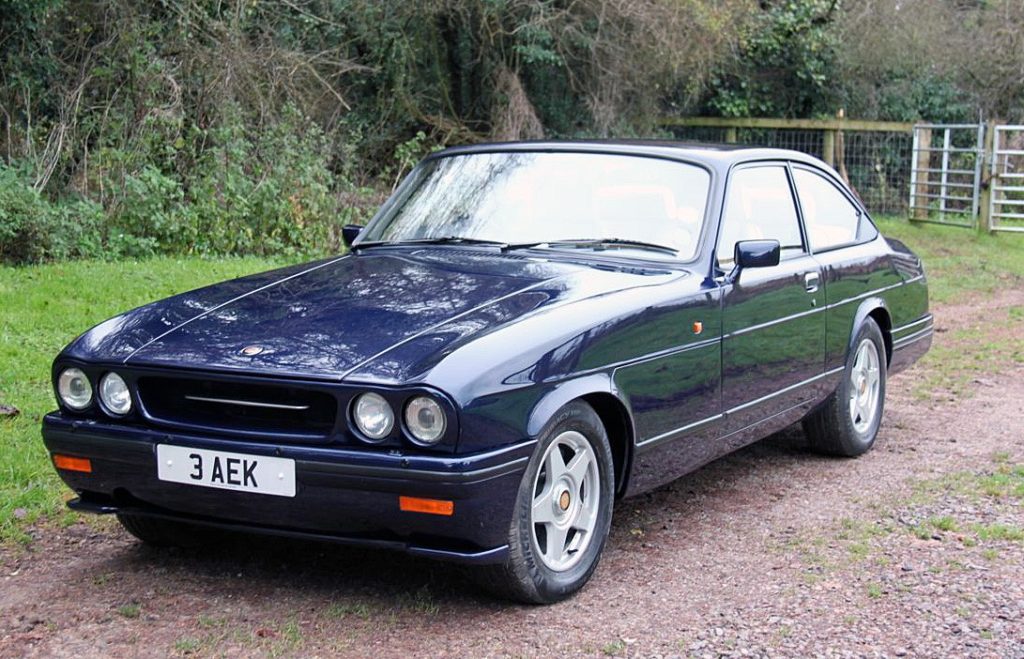
Production commenced on the Blenheim in 1994 and continued with series 2 and series 3. Some 43 Blenheims were produced at a purchase price of £152,000 and this model was the last of the luxury 2-door, four-seater cars produced by the Bristol Car Company.
Some subtle changes to the body of the Britannia and the use of turbo boost to the 5900cc engine gave a top speed of 150mph (limited) and 0-60 time of 5.7 sec. The engine, four-speed auto transmission and exhaust were tuned by Bristol to handle the generous amount of power. Rear track was lengthened and revised rear axle ratio used stiffer antiroll bars, bigger 4 pot piston brakes and 15” wheels with 225/70 tyre aspect ratio gave a firmer ride. The last of the “Gentleman’s Express".
SPECIFICATIONS
Engine — V8 @ 90 degrees by Chrysler. 5900 CC, overhead valves, compression ratio of 9-1. Computer controlled mixture, timing and emissions, turbo charged, bhp not specified
Gearbox — Chrysler Torqueflite 4-speed automatic
Size — Overall Length: 15’11” (4860) Overall Height: 4’8” (1440) Overall width: 5'9" (1750)
Brakes — Girling discs with Lockheed vacuum servo. Disc diameter 11½ inches front and rear
Steering — ZF recirculating ball power assisted. 3 turns lock to lock Turning Circle 36ft
Suspension — Front: Independent transverse wishbones, coil springs Telescopic dampers. Rear: Live axle, telescopic dampers, anti-roll bar
Weight — 3850lbs (1746kg)
Tyres — 215” x 15”
Fuel tank — 18 gallons
Bristol Blenheim Speedster
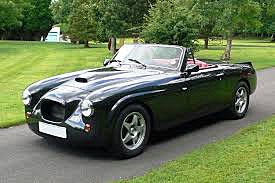
Only three of this model were constructed and sold for £149,225. The Speedster was not even actually launched or previewed. It just turned up one day at the company’s one and only showroom at 368-370 Kensington High Street, London. Tony Crook, the owner of the company, took in a partner, named Toby Silverton, who was passionate about all things Bristol. The Speedster evolved from a “find” shoved under a heap of bits and pieces in the back of a workshop, where it had lain for years. It was a chopped version of a 404, that was done at a time where someone had an idea for a convertible to go up against the Arnolt Bristol, an open top sports car designed in Italy and built by “Wacky” Arnolt, an eccentric American entrepreneur.
The car was nicknamed the “Bullet” and was fitted with a V8 engine. Toby discovered it and set about developing the car into his own plaything. The car now lives in Florida, having been built to all Bristol Blenheim specifications, with a slightly longer tail and slightly flared guards to house the 255/55 17-inch wheels and tyres, plus all modern running gear. The Bullet is capable of a top speed well in excess of 150mph.
SPECIFICATIONS
Engine — V8 @ 90 degrees by Chrysler. 5900 CC, overhead valves, compression ratio of 9-1
Gearbox — Chrysler Torqueflite 4-speed automatic
Bristol Fighter
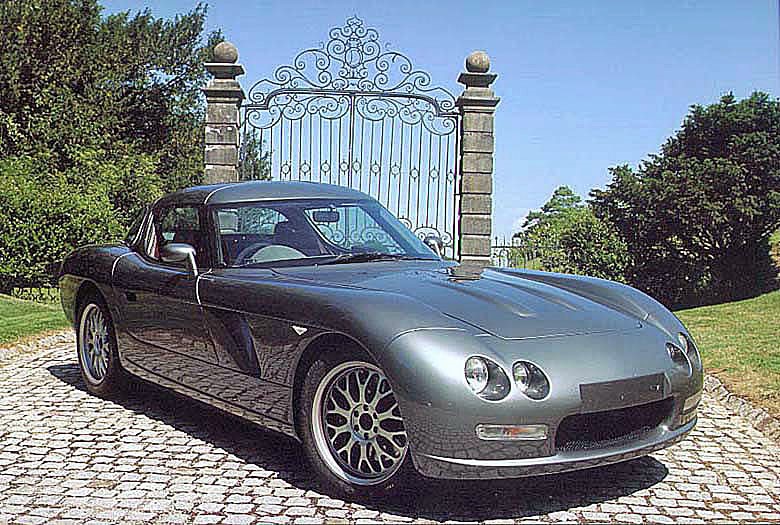
The last Bristol produced by the Bristol Car Company from 2004 to 2011. The purchase price was £235,000 and there were 13 produced. The Bristol Fighter is a genuine super car, with a sports body and gullwing doors, designed by Brabham Formula One engineer, Max Boxtrom. It has a Cd of 0.28. The Fighter uses a front V10 engine of 7,996 CC (487.9 CI) based on the Dodge Viper and modified by Bristol to produce 545hp at 5,600 rpm. The more powerful later Fighter S is tuned to 628hp, using a very clever ram air effect, through the design of the air intake. It uses a 6-speed transmission, or a 4-speed auto, accelerating 0-100 kms in 4 seconds, with a top speed of 340kph. All this with a driver of 6 foot 7inches in comfort. A later version was planned, with turbo power in excess of 1000bhp, an equal to the Bugatti Veyron, but it never came to fruition, as the company ceased production in 2011.
Bristol has been saved from extinction by Frazer Nash, who specialise in electric motors for the future, so one day, we may see Bristols on the road again, powered by electrics.
SPECIFICATIONS
Engine — V10 @ 90 degrees by Chrysler. 7,996 CC, overhead valves, compression ratio of 9-1. Fuel Injection, 545 BHP 5,600 rpm
Gearbox — 6-speed manual or 4-speed Automatic
Size — Overall Length: 4420mm Overall width: 1795mm
Brakes — Power Assisted Discs on all wheels
Steering — Power Rack and Pinion
Suspension — Front and rear: Double Wishbones and Coil Springs. Fully independent on all four wheels
Weight — 1540kg
Tyres — 265/80 R18
Fuel tank — 18 gallons
Bristol Bullet
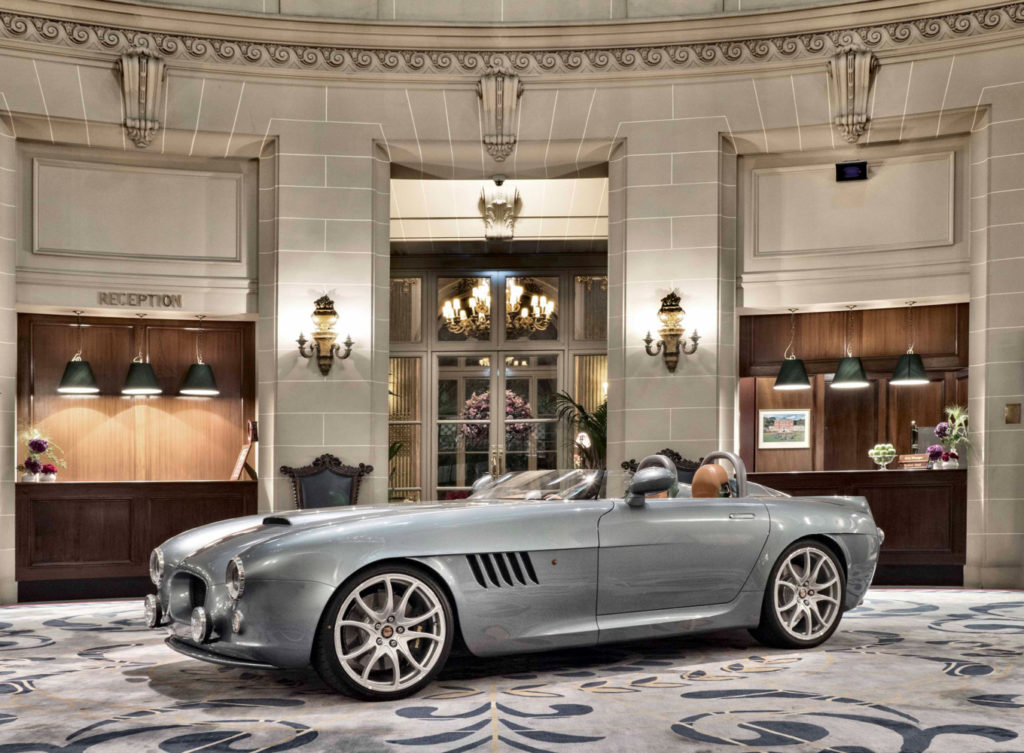
The new Bristol Bullet speedster produced by Kamkorp Autokraft, a division of the Frazer Nash Group, is powered by a BMW V8 engine and was launched in September 2016.
The Bullet celebrates Bristol Car's 70th anniversary and represents the marque's return after going into receivership in 2011. The Bullet's styling draws on the 405dh and the Blenheim Speedster, with bodywork fabricated in carbon fibre.
Interior upholstery and trim are in the finest British hides with dashboard panelling choices of traditional wood or various carbon-fibre weaves. A 7" touchscreen and wifi smartphone connectivity provide an up-to-date infotainment package.
The engine is a powerful, naturally aspirated V8 manufactured by BMW and finished by Bristol. It is named the Hercules, after the Bristol Hercules 14-cylinder, 1300hp radial engine which powered aircraft such as the Bristol Beaufighter. The 4.8L engine develops 370 BHP with 490 Nm of torque available. A choice of 6-speed manual, or 6-speed automatic (with sequential sports shift function) gearboxes is offered.
SPECIFICATIONS
Engine — V8 by BMW. 4.8L developing 370 BHP and 490 Nm of torque
Gearbox — 6-speed manual or 6-speed automatic with sequential sports shift
Size — Overall Length: 4200mm Overall width: 1860mm Overall height: 1200mm. Wheelbase: 2553mm
Brakes — Front: 6-piston aluminium caliper, 348 x 32mm ventilated steel disc. Rear: 2-piston aluminium caliper. 332 x 26mm ventilated steel disc. ABS and EBD
Steering — Power Rack and Pinion
Suspension — Front and rear: Double Wishbones and Coil Springs. Fully independent on all four wheels
Weight — Kerb Weight: 1,100 kg, Gross Vehicle Weight: 1,250 kg
Tyres — Alloy wheels: 19 X 8.5”. Front 225/35R19 / Rear 245/35R19
Fuel tank — 55 litres
Lighting — Front: LED headlamps with DRL and integrated indicator function. Rear: LED rear lamps with integrated indicator function
Interior features — Heated Seats, Heating / Air conditioning via directional air vents in lower dashboard, Clock: a bespoke timepiece, centrally mounted to the dashboard, USB phone charging point.Tonneau Cover: Mohair two-piece full tonneau cover, offered in a range of colours.
